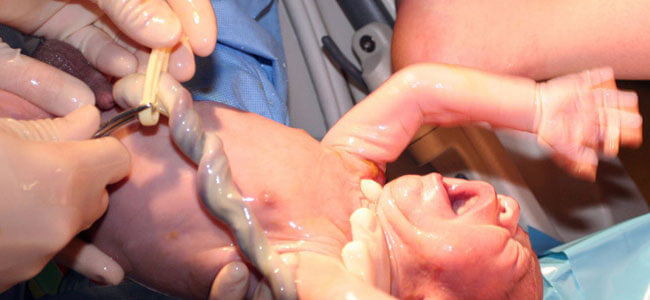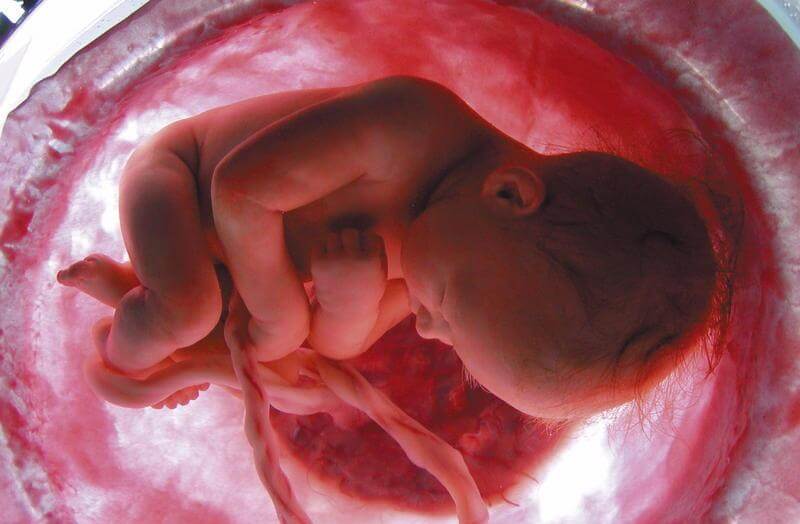What Are the Risks of Umbilical Cord Prolapse?

Most pregnancies come to full term without any complications, yet there are many risks during the long process of gestation. One of the difficulties a fetus can encounter in the uterus is umbilical cord prolapse or compression.
Generally speaking, it’s true that most pregnancy-related issues can be solved if the process is being monitored. Prenatal consults are very important during all stages of gestation.
The doctor will be very concerned about avoiding a possible umbilical cord prolapse, which can occur during pregnancy or labor.
However, this type of complication is most common during childbirth. Most are mild and have no repercussions. It’s estimated that an umbilical cord compression occurs in at least one out of ten births.
What causes umbilical cord prolapse?
Although it’s most common during birth, umbilical cord prolapse can also occur during the final months of pregnancy. The more active the baby, the greater the possibility that the cord will be compressed.
In some cases the compression may be temporary and harmless. It’s also possible for it to occur for long periods without being dangerous.
The umbilical cord is often compressed and stretched throughout the development process. This movement, or the baby’s, doesn’t always compress the cord, but it can happen.
During birth, it’s more common for stretching and compression to result in umbilical cord prolapse.

It’s rare for the baby’s in-utero activity to compress the cord. Rather, the premature rupture of membranes tends to be one of the main causes.
This sometimes occurs close to birth, but when it happens before the 32nd week, umbilical cord compression can occur in as many as 76% of cases.
The umbilical cord is usually compressed when it descends into the birth canal before the baby. This is why it’s more common for this type of compression to occur during birth.
What are the risks of umbilical cord prolapse?
The umbilical cord is part of a baby’s life-support system in the mother’s womb. It’s responsible for transporting nutrients and oxygen to the fetus from the placenta.
Consequently, when the umbilical cord is compressed for a long time, it can result in decreased blood flow and lack of oxygen. Other risks include:
- Change in the fetus’s heart rate, especially related to variable deceleration. This means the baby’s heart rate drops below 115 bpm for longer than 10 minutes. This type of deceleration is normal if it lasts a few minutes, but no more than 10.
- Change in the baby’s blood pressure.
- Presence and accumulation of carbon dioxide in the blood, which can lead to respiratory acidosis.
- Risk of brain damage depending on how long the oxygen deprivation lasts.
- Other health complications caused by possible episodes of fetal hypoxia as the compression occurs.
- Death of the fetus.
Damage to the health of the fetus caused by umbilical cord prolapse depends on how long the compression lasts. The main risk is from oxygen deprivation, which can even lead to death.
These possible complications are rare because doctors are able to monitor and deal with the situation.
Diagnosis and treatment

To diagnose a possible cord compression before birth, a doctor can do a few tests. You can use a fetal doppler or an ultrasound. Without these tests it’s impossible to detect possible signals that there may be a compression.
Once the doctor detects the situation, the main treatment is to apply an amnioinfusion, which is an infusion of saline solution into the uterus.
This solution should be at room temperature, to relieve pressure on the cord. This procedure is only applicable when the prolapse occurs during birth.
When the compression is minor, and occurs at another time during the pregnancy, the doctor will attempt to increase the oxygen supply. In other words, the doctor gives the mother oxygen in order to increase blood flow in the umbilical cord.
If the situation becomes more serious, the baby’s vital signs must be monitored.
If the baby shows signs of distress, or their heart rate drops, more drastic measures may have to be taken. Depending on the stage of pregnancy, the doctor may perform a Cesarean to save the baby’s life.
All cited sources were thoroughly reviewed by our team to ensure their quality, reliability, currency, and validity. The bibliography of this article was considered reliable and of academic or scientific accuracy.
- Moldenhauer, J. Prolapso del cordón umbilical. Manual MSD- Versión para profesionales. [En línea].
- Sayed Ahmed, Waleed & Ahmed Hamdy, Mostafa. (2018). Optimal management of umbilical cord prolapse. International Journal of Women’s Health. Volume 10. 459-465. 10.2147/IJWH.S130879
- Valenti, Eduardo A. Guía de procidencia de cordón. Revista del Hospital Materno Infantil Ramón Sardá. 2008, 27. [En línea] Disponible en:http://www.redalyc.org/articulo.oa?id=91211281005ISSN 1514-9838
This text is provided for informational purposes only and does not replace consultation with a professional. If in doubt, consult your specialist.
